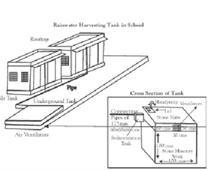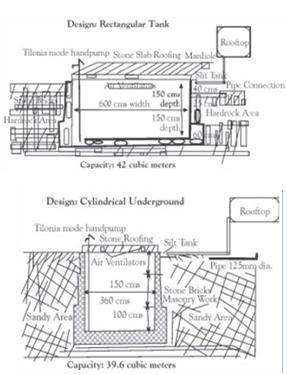Introduction to Rainwater Harvesting
Introduction to Rainwater Harvesting
The collection and storage of rain water for later productive use is defined as rainwater harvesting. It is simply collecting, storing and purifying the naturally soft and pure rainfall that falls upon your roof.
Why harvest rainwater?
Today, scarcity of good quality water has become a major cause of concern. However rain water which is pure and of good quality is lost as run off.
Benefits of rainwater harvesting
- Can supplement other sources of water supply such as groundwater or municipal water connections
- Ability to build or farm in areas with no other water supply
- High quality water - pure, free of chemicals
- Lower water supply cost
- Reduced flood flows and hence reduced topsoil loss
RWH is most suitable where ...
- groundwater is scarce
- groundwater is contaminated
- terrain is rugged or mountainous
- seismic & flooding events are common
- the aquifer is at risk of saltwater intrusion
- population density is low
- electricity & water prices are rising
- water is too hard or mineral laden
Rainwater may be utilized for
- drinking, cooking, bathing (potable quality)
- toilet flushing
- washing clothes
- irrigation
- livestock requirements
How to Harvest the Rain
Any rainwater harvesting system has three components: Catchment, Conveyance, and Storage. There are two classes of rainwater harvesting systems:
- Systems which collect roof runoff for household use.
- Systems which use in field or adjoining catchment to provide supplemental irrigation for agriculture.

- Catchment: roof surface to collect the rain
- Conveyance: channels or pipes from roof or catchment area to storage
- Roof washing: ‘first flush’ diverter system to filter and remove contaminants
- Storage: cisterns or tanks where collected rainwater is securely stored – i.e. insect proof
- Purification: includes filtration, ozone or UV light to purify the collected rainwater for potable use
- Distribution: system that delivers the rainwater, usually including a small pump and pressure tank
Rain water harvesting in rural areas
- Build community wells in a few places in the village. Within 10-20 feet from the well, construct a bore-well using a hand-operated pump. Educate the villagers to keep the area around the well and the bore well clean - no washing (human, cattle, motor cycles, clothing), no defecation. If there are existing water tanks in the village, desilt and clean them every 3 years. If there are any small rivers or streams, build check-dams across them to hold the rain water for usage after the rains have stopped. Take up roof water harvesting
- Roof water harvesting rural schools: Rainwater Harvesting (RWH) from roofs is a simple low cost technique that has been practiced for hundreds of years in the desert areas of India. For over two decades, the Barefoot College has provided drinking water in remote rural schools in 15 states for about 32 million people by collecting rainwater from rooftops of the schools and storing it in underground tanks.
RWH structures serves two purposes:
- A source of potable water, especially during the dry season (4- 5 months)
- Year-round water provision to improve hygiene, e.g. low-flush public toilets.
Rain Water Harvesting ( RWH) Project for School Rainwater Harvesting Tank in School :
Before construction of a RWH system, it is necessary to gather information about schools that face shortage of water, existing water resources in the village, roof top area where RWH could be taken up and types of soil in the village.
Why are underground tanks built for rainwater storage?

- Only an underground tank built in lime or local material can keep rainwater fresh till the next rainy season.
- This is a natural water storage device - providing warm water in winter and cold in summer.
- Underground tanks are more durable and maintenance free unlike the above ground level tank.
Location of Tank
- Tank should be close to the main building with an easy access for school children.
- The distance of tank from the building depends upon the area: 3 to 5 feet in hard subsurface in soft formation, distance should be more (10 ft.)
- Minimum length of pipes should be used to avoid chances of blockage. Large diameter pipes (at least 4 inches) are suggested to connect rooftop to tank.
- If subsurface is hard, do not try to dig a pit too deep. A tank can be raised 1/3rd above the ground surface and 2/3rd in the ground
Material for Construction
- Local building material (bricks/ stones)
- Lime/cement
- Water proofing powder (gypsum)
- Coarse sand
- Roofing material (Ferro cement/sandstone slabs) depends upon area.
Shape of the tank

The shape of the tank depends upon the soil type. The basic traditional designs are rectangular and cylindrical (round). A rectangular tank is good for hard rock area. The technique is simple: Dig a pit and cover it with a roof made of local stones. The rooftop tank can be used for holding classes in winter or as a stage for the school.
The cylindrical design is particularly suitable for the desert area. The knowledge of traditional and inexpensive construction technique of water structures is with the village community of the Thar Desert. It is incredible but true that local village masons and architects can construct cylindrical tanks and deep wells of upto 100 mts deep using locally available material. These cylindrical tanks are a challenge to build even for trained civil engineers.
Facts on underground sources of water
- A well is not for storing water. The well connects the surface to the underground water sources. Based on the underground water availability during a rainy season, the water level in the well will go up and down.
- Long after the rains have stopped, the well gets its water from the underground sources leaking into it.
- Where you get water using a bore-well, rain water did percolate through any soil structure at the ground level, including rocky, laterite rock surface.
- Every bore well will eventually go dry, some sooner, some later.
- Use a bore well in reverse. Use a dried up bore well to recharge the underground supply by adding a percolation pit at the top
Related Resources
- Traditional water harvesting structures in India
- Three main Design Concepts of RWH displayed at the Rain Centre
- Basics of Rainwater Harvesting
- Making of a Recharge pit
- Availability of rain water through roof top rain water harvesting
- Ground water recharging techniques
- Manual on Rainwater Harvesting for Schools
- Rain Water Harvesting
- Rain Water Club
- India Water Portal
- Harvesting Rainwater
Source: CGWB
Last Modified : 8/17/2020
This topic provides about *99# Service- Innovative...
This topic provides information about Zero tillage...
This topic provides information related to steps t...
This topic explains about psychological human deve...

